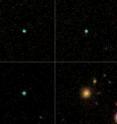Galaxy Zoo hunters help astronomers discover rare 'Green Pea' galaxies
A team of astronomers has discovered a group of rare galaxies called the "Green Peas" with the help of citizen scientists working through an online project called Galaxy Zoo. The finding could lend unique insights into how galaxies form stars in the early universe. The Galaxy Zoo users, who volunteer their spare time to help classify galaxies in an online image bank, came across a number of objects that stuck out because of their small size and bright green color. They dubbed them the Green Peas.
Employing the help of the volunteers to further analyze these strange new objects, the astronomers discovered that the Green Peas are small, compact galaxies forming stars at an incredibly high rate.
"These are among the most extremely active star-forming galaxies we've ever found," said Carolin Cardamone, an astronomy graduate student at Yale and lead author of the paper, to be published in an upcoming issue of the Monthly Notices of the Royal Astronomical Society.
Of the one million galaxies that make up Galaxy Zoo's image bank, the team found only 250 Green Peas. "No one person could have done this on their own," Cardamone said. "Even if we had managed to look through 10,000 of these images, we would have only come across a few Green Peas and wouldn't have recognized them as a unique class of galaxies."
The galaxies, which are between 1.5 billion and 5 billion light years away, are 10 times smaller than our own Milky Way galaxy and 100 times less massive. But surprisingly, given their small size, they are forming stars 10 times faster than the Milky Way.
"They're growing at an incredible rate," said Kevin Schawinski, a postdoctoral associate at Yale and one of Galaxy Zoo's founders. "These galaxies would have been normal in the early universe, but we just don't see such active galaxies today. Understanding the Green Peas may tell us something about how stars were formed in the early universe and how galaxies evolve."
The Galaxy Zoo volunteers who discovered the Green Peas—and who call themselves the "Peas Corps" and the "Peas Brigade"—began discussing the strange objects in the online forum. (The original forum thread was called "Give peas a chance.")
Cardamone asked the volunteers—many of whom had no previous astronomy background or experience—to refine the sample of objects they detected in order to determine which were bona fide Green Peas and which were not, based on their colors. By analyzing their light, Cardamone determined how much star formation is taking place within the galaxies.
"This is a genuine citizen science project, where the users were directly involved in the analysis," Schawinski said, adding that 10 Galaxy Zoo volunteers are acknowledged in the paper as having made a particularly significant contribution. "It's a great example of how a new way of doing science produced a result that wouldn't have been possible otherwise."
Source: Yale University
Articles on the same topic
- Cosmic dance helps galaxies lose weightWed, 29 Jul 2009, 18:39:58 UTC
Other sources
- Total Amateurs Discover 'Green Pea' Galaxiesfrom Live ScienceThu, 30 Jul 2009, 18:42:13 UTC
- Cosmic Dance Helps Galaxies Lose Weightfrom PhysorgWed, 29 Jul 2009, 19:21:15 UTC
- Cosmic Dance Helps Galaxies Lose Weightfrom Science DailyWed, 29 Jul 2009, 19:14:10 UTC
- Cosmic dance helps galaxies lose weightfrom Science BlogWed, 29 Jul 2009, 18:35:29 UTC
- "GREEN PEA" PICTURES: New Galaxy Class Discoveredfrom National GeographicWed, 29 Jul 2009, 13:35:10 UTC
- Galaxies going greenfrom Sciencenews.orgTue, 28 Jul 2009, 22:49:18 UTC
- Total Amateurs Discover 'Green Pea' Galaxiesfrom Space.comMon, 27 Jul 2009, 22:14:11 UTC
- Galaxy Zoo Hunters Help Astronomers Discover Rare 'Green Pea' Galaxiesfrom Science DailyMon, 27 Jul 2009, 21:21:27 UTC
- Galaxy Zoo hunters help astronomers discover rare 'Green Pea' galaxiesfrom PhysorgMon, 27 Jul 2009, 18:35:19 UTC
- Galaxy Zoo hunters help astronomers discover rare 'Green Pea' galaxiesfrom Science BlogMon, 27 Jul 2009, 17:35:10 UTC
